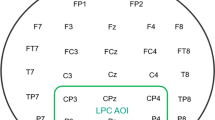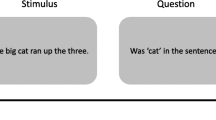Abstract
The present study investigated the effects of phrase length and scrambling in the processing of Japanese sentences. Reading times of short phrases, long phrases, verbs, and whole sentences, measured by the method of self-paced reading, did not differ in terms of phrase-length order and scrambling. In addition, four types of sentences constructed on the basis of phrase-length order and scrambling did not affect duration times of correctness decision-making for sentences. However, error rates differed between canonical and scrambled sentences regardless of phrase-length order. This result implies that scrambled sentences were harder to judge as correct sentences than canonical sentences. Thus, scrambling affects the appropriate integration of information, whereas phrase-length order is simply an indication of preference and not of cognitive processing. To explain the present result, the authors propose the “configurational structure without movement,” which predicts no difference in speed between the processing of canonical and scrambled sentences, apart from error rates.
Similar content being viewed by others
REFERENCES
Aoshima, S., Phillips, C., & Weinberg, A. (2002). Active filler effects and reanalysis: A study of Japanese Wh-scrambling constructions. University of Maryland Working Papers in Linguistics, 12, 1-24.
Bock, K. (1982). Towards a cognitive psychology of syntax: Information processing contributions to sentence formulation. Psychological Review, 89, 1-47.
Bock, K. (1986). Meaning, sound, and syntax: Lexical priming in sentence production. Journal of Experimental Psychology: Learning, Memory, and Cognition, 12, 575-586.
Bock, K., & Warren, R. (1985). Conceptual accessibility and syntactic structure in sentence formation. Cognition, 21, 47-67.
Chujo, K. (1983). Nihongo tanbun-no rikai katei—Bunrikai sutoratojii no sougo kankei [The interrelationships among strategies for sentence comprehension] [in Japanese]. Japanese Journal of Psychology, 54, 250-256.
Farmar, A. (1984). Modularity in syntax: A study of Japanese and English. Cambridge, MA: MIT Press.
Frazier, L., & Clifton Jr., C. (1989). Successive cyclicity in the grammar the parser. Language and Cognitive Processes, 4, 93-126.
Frazier, L., & Flores d' Arcais (1989). Filler-driven parsing: A study of gap filling in Dutch. Journal of Memory and Language, 28, 331-344.
Fukui, N. (1989). Nichi/ei-go hikaku toogo-ron [Contrastive syntax of Japanese and English]. In K. Inoue (Ed.), Nihon bunpoo shoo-jiten [The small dictionary of Japanese grammar] (pp. 89-108) [in Japanese]. Tokyo: Taishukan Shoten.
Gunji, T., & Sakamoto, T. (1999). Gengogaku-no hoohoo [Methodology of Linguistics] [in Japanese]. Tokyo: Iwanami Shotten.
Hale, K. (1980). Remarks on Japanese phrase structure: Comments on the papers on Japanese syntax. MIT Working Papers in Linguistics, 2, 185-203.
Hale, K. (1981). On the position of Warlpiri in a typology of the base. Bloomington, IN: IULC.
Harada, S.-I. (1977). Nihongo-ni 'Henkei'-wa Hitsuyooda [Transformation is necessary in the Japanese language] [in Japanese]. Gengo [Language], 6, 10-11, 88–95, 96–103.
Hirose, Y., & Inoue, A. (1998). Ambiguity of reanalysis in parsing complex sentences in Japanese. In D. Hillert (Ed.), Syntax and semantics: Vol. 31. Sentence processing: A crosslinguistic perspective (pp. 70-93). San Diego: Academic Press.
Hoji, H. (1985). Logical form constraints and configurational structure in Japanese. Ph. D. dissertation, University of Washington.
Mazuka, R., Itoh, K., & Kondo, T. (1997). Processing down the garden path in Japanese: Processing of sentences with lexical homonyms. Journal of Psycholinguistic Research, 26, 207-228.
Miyagawa, S. (1989). Structure and case marking in Japanese: Syntax and semantics (Vol. 22). San Diego: Academic Press.
Miyagawa, S. (1997). Against optional scrambling. Linguistic Inquiry, 28, 1-25.
Nakayama, M. (1995). Scrambling and probe recognition. In R. Mazuka & N. Nagai (Eds.), Japanese sentence processing. Hillsdale, HJ: Erlbaum.
Nakayama, M. (1999). Sentence processing. In M. Tsujimura (Ed.), The handbook of Japanese linguistics (pp. 398-424). Malden, MA: Blackwell.
Nemoto, N.(1999). Scrambling. In M. Tsujimura (Ed.), The handbook of Japanese linguistics (pp. 121-153). Malden, MA: Blackwell.
Ross, J.-R. (1967). Constraints on variables in syntax. Ph. D. dissertation, Cambridge, MA: MIT.
Saito, M. (1985). Some asymmetries in Japanese and their theoretical implications. Ph.D. dissertation, Cambridge, MA: MIT.
Saito, M., & Hoji, H. (1983). Weak cross-over and move α in Japanese. Natural Language & Linguistic Theory, 1, no & f 245-259.
Sakamoto, T. (1996). Processing empty subjects in Japanese: Implications for the transparency hypothesis. Fukuoka: Kyushu University Press.
Sakamoto, T. (2001). Bun-no rikai: Kakimaze bun [Understanding of sentences: Scrambling] [in Japanese]. Gengo [Language], 30, (10), 106-111.
Sakamoto, T. (2002). Processing filler-gap constructions in Japanese. In M. Nakayama (Ed.), Sentence processing in east Asian languages (pp. 189-221), Stanford, CA: CSLI Publications.
Taft, M. (1991). Reading and the mental lexicon. Hillsdale, NJ: Lawrence Erlbaum Associates.
Tamaoka, K., & Hatsuzuka, M. (1995). Kanji niji jukugo no shori ni okeru kanji shiyoo hindo no eikyoo [The effects of Kanji printed-frequency on processing Japanese two-morpheme compound words] [in Japanese with a substantial English summary]. Dokusho Kagaku [The Science of Reading], 39, 121-137.
Tamaoka, K., & Takahashi, N. (1999). Kanji niji jukugo no shoji kodo ni okeru goi shiyo hindo oyobi shoji-teki fukuzatu-sei no eikyo [The effects of word frequency and orthographic complexity on the writing process of Japanese two-morpheme compound words] [in Japanese]. Japanese Journal of Psychology 70, 45-50.
Ueyama, A. (1999). Two types of scrambling constructions in Japanese. In A. Barss & T. Langendoen (Eds.), Anaphora: A reference guide. Cambridge MA: Blackwell.
Whitmann, J. (1987). Configurationality parameters. In T. Imai & M. Saito (Eds.), Issues in Japanese linguistics, Dordrecht: Foris.
Yamashita, H. (1997). The effects of word-order and case marking information on the processing of Japanese. Journal of Psycholinguistic Research, 26, 163-188.
Yamashita, H., & Chang, F. (2001). “Long before short” preference in the production of a head-final language. Cognition, 81, B45-B55.
Author information
Authors and Affiliations
Rights and permissions
About this article
Cite this article
Tamaoka, K., Sakai, H., Kawahara, Ji. et al. The Effects of Phrase-Length Order and Scrambling in the Processing of Visually Presented Japanese Sentences. J Psycholinguist Res 32, 431–454 (2003). https://doi.org/10.1023/A:1024851729985
Issue Date:
DOI: https://doi.org/10.1023/A:1024851729985




